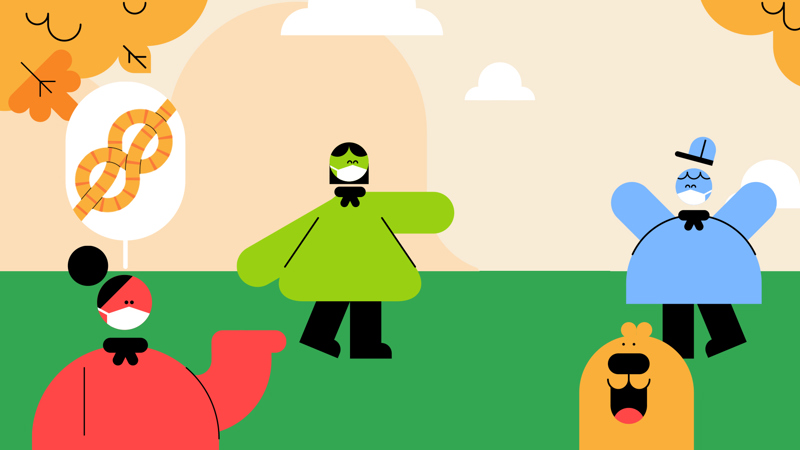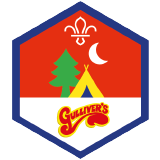
Tie, match and build
You’ll need
- Device with access to the internet
- Scissors
- Pens or pencils
- Scrap paper
- Access to water
- Tables
- Whistles
- Compass
- String
- Torch or phone
- Buckets
- Access to a printer
- Cones
- Map
- Buckets
Before you begin
- Use the safety checklist to help you plan and risk assess your activity. Additional help to carry out your risk assessment, including examples can be found here. Don’t forget to make sure all young people and adults involved in the activity know how to take part safely.
- Make sure you’ll have enough adult helpers. You may need some parents and carers to help if you’re short on helpers.
Setting up this activity
- You’ll need two different colours of cones.Put two cones for each team on the opposite side of the space. The cones should be different colours, such as red and green.
- Make sure you have enough volunteers to help with this activity. They should stand behind the tables and help people. They’ll also need to tell each person which activity to do.
- Set up the tables at one end of the space. You’ll need one for each team.
- Place all the equipment for each challenge on the tables for everyone to see.
- Prepare the equipment for each challenge. You’ll need enough sets for each team to have their own:
For Tie a reef knot, you’ll need two pieces of string about 20cm long.
For Match equipment, you’ll need a compass, a whistle, a map, a torch and paper with the names written on for each of them.
For Match the habitat, you’ll need pictures of a squirrel, hedgehog, badger, robin, tree, a hedge, a sett and a nest.
For Build a raft, you’ll need some sticks, two pieces of string about 40cm long, a bucket of water and something to test the raft, such as a bowl of water.
Ready to relay
- Everyone should split into groups of up to four people.
- Each team should line up behind a red cone.
- The first person in each team should run to their team’s table and complete the challenge.
- When an adult says they’re finished, they run back to the empty (green) cone next to their team. Once they’re behind the green cone, the next person in their team should go.
- You could demonstrate what you mean if people aren’t sure. We’ve included instructions for the bases below.
- The first team to have all their members behind the green cone is the winner.
- If people would like to play again, reset all of the equipment. Rearrange the order in the teams so that everyone has a chance to do another activity.
To complete this challenge, the player needs to correctly tie a reef knot. An adult should check it before the player runs back to their team.
Practise makes perfect when learning knots. Go through how to tie a reef knot with everyone before this activity.
Activities such as Tie a tasty reef knot and Tie the tarp have instructions to help people learn to tie a reef knot.
To complete this challenge, the player needs to place the four pieces of equipment on the correct names.
Spend some time with everyone going through the equipment before you do this activity. You could do this at your meeting place, online or as part of a navigation activity. Check out Navigate from a distance for some ideas.
To complete this challenge, the player needs to create a raft that’s strong enough to hold the object and float on the water for five seconds.
Give everyone a chance to practise with an activity like Teeny tiny twig rafts. If you need to start by practising your lashings, check out To eat or knot to eat.
To complete this challenge, the player needs to match up the animals with their home.
Check out Nature detective to see what you can learn about animals in your local area.
Reflection
This activity needed everyone to work as a team and use their outdoor knowledge to complete the tasks as fast as they could.
If someone was struggling, how did their team help them? Did they cheer them on or help them figure out the answer?
Were any of the challenges especially tricky? What helped people to dig deep and stick at it?
Perhaps people took a deep breath before giving it another go or asked for some help.
Although this was a race, the really important thing was that people learned something new and had fun. It doesn’t matter if some people weren’t as fast as their friends.
Safety
All activities must be safely managed. You must complete a thorough risk assessment and take appropriate steps to reduce risk. Use the safety checklist to help you plan and risk assess your activity. Always get approval for the activity, and have suitable supervision and an InTouch process.
- Active games
The game area should be free of hazards. Explain the rules of the game clearly and have a clear way to communicate that the game must stop when needed. Take a look at our guidance on running active games safely.
Change the challenges to suit your group. You could change the number of items, add another skill or include things that you’ve been working on recently.
Think about new challenges, such as identifying trees, simple tracking or lighting a piece of cotton wool with a flint or steel
Make sure the course is accessible for everyone. For example, you could tell everyone they need to walk to the tables to make it fairer.
The adults should be there to help anyone who needs support, but people could also work in pairs.
All Scout activities should be inclusive and accessible.
Now everyone’s developed skills, how could you put them to use? You could build a small pioneering project or head out on a walk to explore habitats and practise navigation.
If anyone’s feeling really confident about one of the challenges, they could show everyone else how it’s done before you begin.


